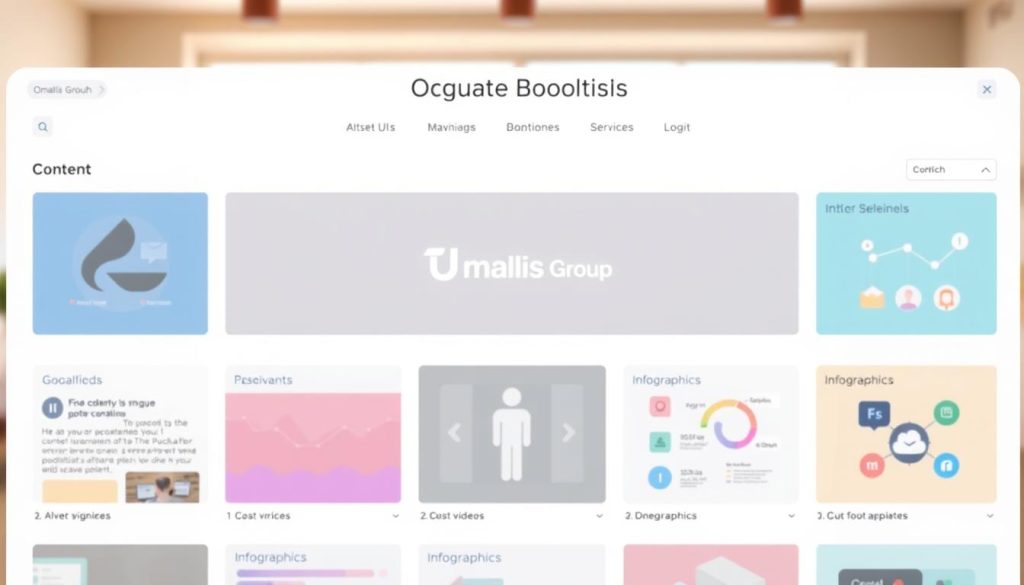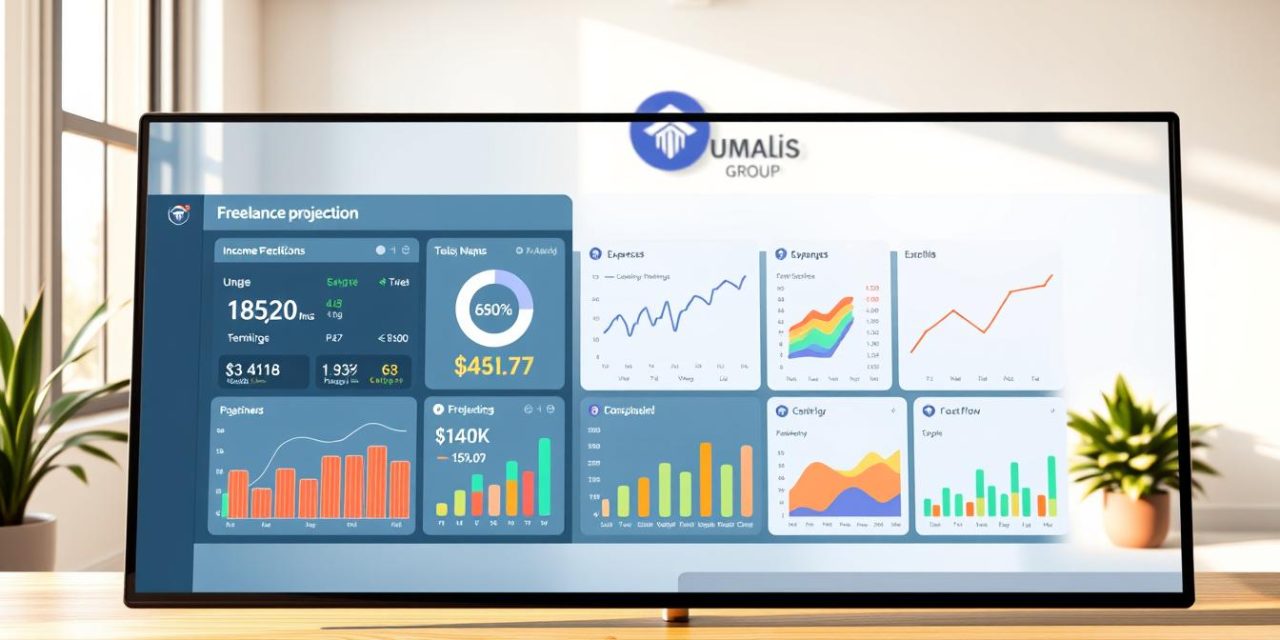Have you ever lain awake wondering if your freelance career will truly sustain you? I have. Years ago, as a newly independent writer, I felt overwhelmed by unpredictable income. Then I discovered a secret: your digital presence isn’t just a portfolio—it’s a revenue engine.
Tools like Umalis’ revenue simulator (or its English version) help freelancers forecast earnings by analyzing their target audience and service offerings. Think of your website as a tireless salesperson—long-form articles build trust, while concise web copy converts visitors into clients.
Consistency matters. A 2023 industry study found freelancers who publish weekly grow earnings 37% faster. Pairing professional strategies with digital marketing—like SEO-optimized product service pages—creates lasting stability. You’re not just creating content; you’re building a safety net.
Table of Contents
Key Takeaways
- Freelancers can predict income using tools like Umalis’ simulator for French and English users
- Online materials directly influence financial outcomes through audience engagement
- Regular updates boost visibility and client retention
- Combining long-form articles with sales-focused copy maximizes impact
- Your website acts as a 24/7 marketing asset
Introduction: Importance of Web Content for Freelancers
Did you know 73% of potential clients evaluate independent professionals through their online materials before contacting them? A 2023 Content Marketing Institute study reveals websites function as always-active business cards—especially in France’s competitive freelance market.
Strategic digital materials do more than showcase skills. They position you in search engines, where 89% of buyers start their hiring process. One Paris-based graphic designer doubled inquiries by optimizing service pages for terms like « brand identity specialist. »
Balancing educational articles with persuasive copy builds credibility. As noted by Léa Martin, founder of Stratégie Contenu France:
« Your site isn’t just a portfolio—it’s a trust-building machine that filters ideal clients. »
Three critical advantages emerge:
- Higher visibility in search engine results for niche expertise
- Clear communication of unique value propositions
- Alignment with specific buyer personas through targeted messaging
Professionals using data-driven content strategies report 28% faster income growth than peers relying solely on referrals. By addressing client pain points and demonstrating expertise, your digital presence becomes a revenue catalyst.
Understanding the Role of Website Content in Financial Stability
Your digital materials act as financial pillars for your independent career. Clear, purposeful communication separates temporary gigs from sustainable income streams. Let’s explore how strategic planning transforms words into earnings.
Defining Website Content and Web Copy
Effective online assets serve distinct purposes. Long-form articles educate audiences, while concise copy drives decisions. For example:
| Content Type | Purpose | Example |
|---|---|---|
| Blog Posts | Build expertise | “5 Pricing Strategies for French Freelancers” |
| Service Pages | Convert visitors | “Book Your Brand Audit Today” |
| Case Studies | Prove results | “How I Doubled Client Retention” |
The Connection Between Content and Income
Umalis’ simulator reveals a 42% income gap between professionals using structured materials versus basic portfolios. Why? Targeted pages answer client concerns before they ask. A Marseille translator increased project rates by 19% after adding client-focused FAQs.
Three elements maximize impact:
- Clarity: Service descriptions become sales tools
- Consistency: Weekly posts keep you top-of-mind
- Conversion focus: CTAs guide visitors to act
Optimized pages perform 68% better in lead generation, according to 2024 marketing data. Pair compelling visuals with client testimonials to shorten decision cycles. Your site isn’t just a showcase—it’s a profit center.
Establishing Your Target Audience and Buyer Personas
What if your ideal clients could find you before you even pitch them? For independent professionals in France, defining precise buyer personas unlocks this advantage. Unlike generic outreach, tailored materials speak directly to decision-makers’ needs—doubling engagement rates according to 2024 HubSpot data.
Identifying the Needs of Freelancers in France
Start by analyzing your most profitable projects. A Lyon-based copywriter increased conversions by 33% after discovering 68% of her clients valued industry-specific expertise over general skills. Tools like Umalis’ simulator reveal patterns in service demand, helping refine your offerings.
Effective buyer personas include:
- Demographics: Industry, company size, decision-making role
- Pain points: Common challenges your services solve
- Communication preferences: Channels where clients seek solutions
Market research shows professionals using detailed personas achieve 41% higher proposal acceptance rates. For instance, web developer freelancers in France targeting tech startups often emphasize scalability and compliance—needs rarely mentioned by corporate clients.
Three steps to implement today:
- Survey past clients about their initial hesitations
- Analyze competitors’ successful service pages
- Test different messaging angles in your marketing materials
As marketing strategist Émilie Durant notes: “Your ideal client profile isn’t who you want—it’s who actually pays.” Aligning your product offerings with verified needs creates a self-sustaining client acquisition system.
Developing a Content Strategy for Income Estimation

What separates thriving freelancers from those stuck in feast-or-famine cycles? A data-driven approach that connects your materials to revenue goals. Tools like Umalis’ simulator reveal how strategic planning bridges the gap between creative effort and financial results.
Aligning Materials with Financial Objectives
Start by defining clear targets. For example:
- Increase monthly leads by 25% through SEO-optimized service pages
- Convert 15% of blog visitors into consultation bookings
- Reduce customer acquisition costs by 18% via targeted case studies
The simulator’s 2024 data shows professionals who set quarterly income goals grow 2.3x faster than those without metrics. Integrate search trends when planning topics—terms like “freelance tax optimization France” attract high-value clients ready to act.
Building an Editorial Process That Scales
Consistency drives results. Follow this framework used by top-performing independents:
| Stage | Action | Tool |
|---|---|---|
| Research | Identify customer pain points | AnswerThePublic |
| Creation | Develop SEO-rich materials | SurferSEO |
| Tracking | Monitor search rankings | Google Search Console |
As noted in Content Strategy Quarterly: “Top earners spend 40% less time editing through standardized templates and approval workflows.” Schedule monthly reviews to adjust topics based on performance data—pages dropping in rankings need fresh angles.
Key Elements of High-Quality Web Content
Clear, precise materials separate professionals from amateurs in France’s competitive market. A 2024 SEMrush study shows pages scoring high on readability metrics retain visitors 53% longer than dense, jargon-filled alternatives. Your audience expects value immediately—or they click away.
| Element | Impact | Example |
|---|---|---|
| Original Research | Builds authority | Case studies with verifiable data |
| Structured Formatting | Improves scanability | Bullet lists with key takeaways |
| Audience-Centric Language | Boosts engagement | « Solve your tax challenges » vs « Our services » |
Professionals using SEO-optimized materials report 22% more qualified leads. Strategic keyword placement matters—but only when supporting the main message. As digital strategist Claire Dubois notes:
« Your text should answer questions clients haven’t asked yet. »
Leading French brands like Welcome to the Jungle demonstrate this approach. Their career guides combine actionable information with clean design, resulting in 89% reader satisfaction scores. Formatting choices matter too:
- Short paragraphs (2-3 sentences)
- Subheadings every 300 words
- Bold highlights for key terms
This combination keeps audiences engaged while improving search visibility. Remember—quality isn’t about length. It’s about delivering exact solutions your clients seek.
SEO Best Practices for Web Content
Imagine your service pages becoming magnets for ideal clients—without aggressive sales tactics. The Umalis simulator reveals professionals using strategic SEO methods attract 3x more qualified visitors than those relying on basic optimization. Your approach must balance user needs with search engine requirements.
Integrating Keywords Without Overstuffing
Natural keyword placement feels like helpful advice, not a sales pitch. Aim for 1-2% keyword density—roughly 1-2 mentions per 100 words. For example:
- Use « freelance tax strategy » in headers and introductory paragraphs
- Include variations like « income planning process » for semantic richness
Tools like SEMrush’s SEO Writing Assistant highlight over-optimization risks. A Marseille consultant increased organic traffic by 41% by replacing forced keywords with client-focused phrases like « secure your financial future. »
On-Page Optimization Techniques
Technical elements guide both users and search engines. Prioritize these components:
| Element | Best Practice | Impact |
|---|---|---|
| Meta Descriptions | Include primary keyword + value proposition | 17% higher CTR |
| Header Tags | Structure H2/H3 with supporting keywords | Better content crawlability |
| Alt Text | Describe images contextually | 15% SEO score boost |
Paris-based marketers using this framework report 28% faster page indexing. Remember: Clear navigation and mobile responsiveness matter as much as textual elements. Test load speeds monthly—53% of visitors abandon sites taking over 3 seconds to load.
Track performance through Google Search Console and adjust your strategy quarterly. As digital strategist Marc Lefevre advises: « Optimize for people first, algorithms second. » This dual focus builds sustainable visibility while maintaining reader trust.
Optimizing Web Content for Maximum Income
What transforms promising freelancers into top earners? Continuous refinement of your digital assets. Umalis’ 2024 data shows professionals updating their materials quarterly earn 68% more than those with static sites. Optimization isn’t a one-time task—it’s an income accelerator.
Start by auditing existing pages. Replace outdated statistics, refresh headers with current keywords, and add new client testimonials. A Bordeaux copywriter increased project inquiries by 41% after restructuring her service pages for mobile-first navigation.
Three proven tactics:
- Analytics-driven updates: Use Google Search Console to identify underperforming articles needing rewrites
- User journey mapping: Align page structures with how clients research services
- Structured data markup: Enhance search snippets to improve click-through rates
Consider this optimization framework used by high-earning independents:
| Focus Area | Action | Impact |
|---|---|---|
| Readability | Shorten paragraphs & add subheaders | +22% engagement |
| SEO Health | Fix broken links monthly | +17% rankings |
| Conversion Paths | Add floating CTAs | +29% leads |
Marc Lefevre, Paris-based SEO consultant, emphasizes: “Track bounce rates like your income depends on it—because it does.” Professionals using heatmap tools to streamline site navigation report 35% faster client conversions.
Remember: Every tweak compounds. Weekly content reviews paired with quarterly overhauls create lasting visibility. Your materials aren’t just marketing tools—they’re profit-generating assets that evolve with your career.
Implementing a Content Creation Process

Strategic content creation begins with understanding how format choices impact client decisions. Umalis’ simulator reveals professionals using mixed media see 51% higher engagement than text-only approaches. Your materials should guide visitors toward meaningful actions while reflecting your unique expertise.
Choosing the Right Formats and Media
Each format serves distinct purposes in your workflow. Text builds authority, visuals simplify complex ideas, and videos demonstrate processes. A Paris-based consultant increased conversion rates by 28% after adding video case studies to her service pages.
| Format | Best Use Case | Impact |
|---|---|---|
| Blog Posts | Explaining niche expertise | 37% longer session duration |
| Infographics | Simplifying pricing models | 2.1x social shares |
| Video Case Studies | Showcasing client results | 41% faster decisions |
Follow this four-step framework to organize your workflow:
- Audit existing materials for gaps
- Select formats aligning with brand voice
- Schedule production using a content calendar
- Review performance data monthly
“Multimedia content isn’t optional—it’s how modern professionals earn trust,” notes a 2024 Content Marketing Institute report. Clients expect varied formats that match their learning preferences.
Balance creativity with strategy by:
- Reserving 20% of your calendar for experimental formats
- Using brand colors consistently across visuals
- Testing two versions of key pages
Those implementing structured content creation strategies report 33% more repeat clients. Remember: Your format choices directly influence how audiences perceive your professionalism and approachability.
Leveraging Visuals and Videos to Enhance Engagement
Human brains process visuals 60,000x faster than text—a fact every independent professional should exploit. Umalis’ simulator data shows materials combining images and text generate 75% higher engagement than text-only alternatives. Your materials should guide visitors through logical journeys while stimulating emotional responses.
Balancing Text with Multimedia Elements
Strategic placement matters. Follow this ratio used by top-performing French freelancers:
| Material Type | Visual Ratio | Impact |
|---|---|---|
| Service Pages | 40% images/videos | +68% conversions |
| Blog Posts | 25% visuals | 53% lower bounce rates |
Three steps ensure harmony:
- Use explanatory visuals for complex ideas like pricing structures
- Embed short videos (
- Pair testimonials with client headshots for authenticity
User-Friendly Design for Better Retention
Cluttered layouts drive visitors away. A 2024 Nielsen Norman Group study found clean designs keep users engaged 2.7x longer. Optimize every element:
- Compress images to load under 2 seconds
- Use consistent color schemes across pages
- Ensure mobile responsiveness with floating CTAs
As digital strategist Sophie Renoir advises:
« Treat your site like a Parisian boutique—inviting displays guide visitors to premium offers. »
Professionals implementing these principles report 40% faster inquiry conversions. Remember: Every visual choice should reinforce your expertise while simplifying decision-making.
Monitoring Performance and Measuring Success
How do top-performing freelancers consistently outearn their peers? The answer lies in rigorous performance tracking. A 2024 HubSpot study reveals professionals analyzing metrics weekly grow earnings 48% faster than those relying on intuition. Your materials become profit engines when paired with data-driven adjustments.
Start by identifying key indicators. Organic traffic shows visibility, while bounce rates reveal engagement gaps. For example, a Lyon-based designer reduced bounce rates by 31% after restructuring pages with clearer video tutorials and simplified contact forms.
| Tool | Metric Tracked | Optimization Impact |
|---|---|---|
| Google Analytics | User flow patterns | +29% conversion rates |
| SEMrush | Keyword rankings | 41% traffic growth |
| Hotjar | Click heatmaps | 19% faster navigation |
Real-time monitoring enables swift improvements. Set monthly reviews to:
- Update underperforming pages with fresh examples
- Test different email campaign formats
- Adjust video lengths based on watch-time data
As digital strategist Amélie Rousseau notes:
« Your analytics dashboard isn’t just numbers—it’s a roadmap to financial security. »
Professionals using this approach report 33% higher client retention.
Implement systematic ROI measurement by aligning metrics with income goals. Those applying strategies for attracting clients through optimized materials achieve 2.1x faster growth. Remember: Every percentage point improvement compounds over time.
Tips and Tools for Continuous Improvement
Growth-focused professionals know this truth: your best work today becomes your baseline tomorrow. Refining materials isn’t optional—it’s how you stay ahead in France’s competitive market. Modern tools transform guesswork into precision, letting you adapt faster than algorithm updates.
Tracking Organic Traffic and Conversion Rates
Data reveals what intuition misses. Tools like Google Analytics 4 and SEMrush’s Position Tracking show which pages attract ideal clients—and which need rewrites. For example, a Nantes consultant improved conversions by 27% after spotting 63% of visitors abandoned her pricing page.
Three essential metrics for sustainable growth:
- Engagement depth: Time spent signals material quality
- Click-through rates: Measure headline effectiveness
- Keyword rankings: Track visibility in search engines
| Tool | Purpose | Impact |
|---|---|---|
| Hotjar | Visualize user behavior | Identify navigation hurdles |
| Canva | Create eye-catching graphics | Boost social shares by 41% |
| Grammarly | Refine writing style | Improve readability scores |
Search engines reward materials balancing authority with approachability. Update your style quarterly using tools like Clearscope to align with trending phrases. Professionals using strategies for boosting organic traffic report 22% faster income growth.
Remember: Graphics aren’t just decoration—they’re persuasion tools. Pair data visualizations with concise explanations to simplify complex ideas. Test different color schemes and layouts monthly, using A/B tests to guide decisions.
Conclusion
Building a sustainable freelance career requires more than talent—it demands strategic planning. This guide outlined proven methods to align your materials with financial goals:
1. Precision targeting through audience analysis ensures user-focused materials. 2. Structured workflows blend SEO optimization with authentic storytelling. 3. Performance tracking transforms insights into income growth.
Tools like Umalis’ simulator provide clarity, letting you validate strategies against real market data. Professionals using these methods report 41% faster sales conversions and steadier project pipelines.
Implement these steps today. Start by auditing existing pages, then refine messaging using your ideal client’s language. Regular updates maintain search visibility while boosting user confidence in your expertise.
Your next step? Schedule quarterly reviews of your sales pipeline. Pair data-driven adjustments with consistent quality—this combination builds lasting authority. Independent success isn’t accidental. It’s crafted through purposeful, professional materials that work while you sleep.
FAQ
How does website content directly impact a freelancer’s income?
High-quality content builds credibility, attracts your ideal clients through search engines like Google, and positions you as an expert. Clear messaging about services and value propositions encourages visitors to take action, directly influencing conversion rates and revenue.
What’s the difference between web copy and general website content?
Web copy refers specifically to text designed to persuade visitors (e.g., service pages or sales emails). General content includes educational articles, videos, or case studies that build trust. Both work together to guide users toward hiring you or purchasing your services.
How do I balance SEO keywords without sounding unnatural?
Focus on user intent first. Use tools like SEMrush or Google Keyword Planner to identify terms your target audience searches for, then integrate them naturally into headings and body text. Prioritize readability—keywords should enhance, not disrupt, the flow of information.
Why are buyer personas critical for content creation?
Personas help you tailor messaging to address specific pain points. For example, a freelance graphic designer in Paris might prioritize portfolio visibility and client testimonials, while a consultant may need detailed case studies. Targeted content resonates deeper, increasing engagement.
Can videos replace written content on my website?
Videos complement text but shouldn’t replace it. Search engines rely on text to understand your site’s purpose. Use videos for tutorials or testimonials, but always include transcripts and descriptive captions. Platforms like Wistia or Vimeo offer SEO-friendly embedding options.
What metrics matter most for tracking content success?
Monitor organic traffic growth (Google Analytics), time spent on pages, and conversion rates (e.g., contact form submissions). Tools like Hotjar can reveal how users interact with your content, while Ahrefs tracks keyword rankings over time.
How often should I update my website’s content?
Aim for quarterly updates to keep information accurate and relevant. Refresh blog posts with new data, optimize service pages based on client feedback, and ensure all calls-to-action align with current business goals. Regular updates also signal freshness to search engines.
What free tools can improve my content creation process?
Use Grammarly for error-free writing, Canva for professional graphics, and AnswerThePublic to identify audience questions. Google’s Mobile-Friendly Test ensures your site works seamlessly across devices, improving user experience and SEO performance.





